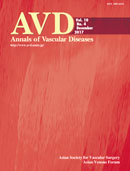10 巻, 4 号
選択された号の論文の26件中1~26を表示しています
- |<
- <
- 1
- >
- >|
REVIEW ARTICLES
Current Trend in the Treatment of Vascular Diseases in Patients with Endstage Renal Disease on Hemodialysis
-
2017 年10 巻4 号 p. 327-337
発行日: 2017/12/25
公開日: 2017/12/25
[早期公開] 公開日: 2017/12/08PDF形式でダウンロード (709K)
Topics and Treatment of Venous Thromboembolism
-
2017 年10 巻4 号 p. 338-344
発行日: 2017/12/25
公開日: 2017/12/25
[早期公開] 公開日: 2017/10/30PDF形式でダウンロード (6186K)
ORIGINAL ARTICLES
Selection from Japanese Journal of Vascular Surgery 2016
-
2017 年10 巻4 号 p. 345-350
発行日: 2017/12/25
公開日: 2017/12/25
[早期公開] 公開日: 2017/09/12PDF形式でダウンロード (672K) -
2017 年10 巻4 号 p. 351-358
発行日: 2017/12/25
公開日: 2017/12/25
[早期公開] 公開日: 2017/11/17PDF形式でダウンロード (1614K) -
2017 年10 巻4 号 p. 359-363
発行日: 2017/12/25
公開日: 2017/12/25
[早期公開] 公開日: 2017/11/17PDF形式でダウンロード (548K)
Selection from the Japanese Journal of Phlebology 2016
-
2017 年10 巻4 号 p. 364-370
発行日: 2017/12/25
公開日: 2017/12/25
[早期公開] 公開日: 2017/12/11PDF形式でダウンロード (867K) -
2017 年10 巻4 号 p. 371-377
発行日: 2017/12/25
公開日: 2017/12/25
[早期公開] 公開日: 2017/12/08PDF形式でダウンロード (496K)
ORIGINAL ARTICLES
-
2017 年10 巻4 号 p. 378-385
発行日: 2017/12/25
公開日: 2017/12/25
[早期公開] 公開日: 2017/10/23PDF形式でダウンロード (479K) -
2017 年10 巻4 号 p. 386-390
発行日: 2017/12/25
公開日: 2017/12/25
[早期公開] 公開日: 2017/10/05PDF形式でダウンロード (1430K) -
2017 年10 巻4 号 p. 391-397
発行日: 2017/12/25
公開日: 2017/12/25
[早期公開] 公開日: 2017/11/24PDF形式でダウンロード (4635K) -
2017 年10 巻4 号 p. 398-401
発行日: 2017/12/25
公開日: 2017/12/25
[早期公開] 公開日: 2017/10/23PDF形式でダウンロード (319K) -
2017 年10 巻4 号 p. 402-406
発行日: 2017/12/25
公開日: 2017/12/25
[早期公開] 公開日: 2017/10/13PDF形式でダウンロード (476K) -
2017 年10 巻4 号 p. 407-410
発行日: 2017/12/25
公開日: 2017/12/25
[早期公開] 公開日: 2017/10/30PDF形式でダウンロード (303K) -
2017 年10 巻4 号 p. 411-416
発行日: 2017/12/25
公開日: 2017/12/25
[早期公開] 公開日: 2017/12/01PDF形式でダウンロード (408K) -
2017 年10 巻4 号 p. 417-422
発行日: 2017/12/25
公開日: 2017/12/25
[早期公開] 公開日: 2017/11/29PDF形式でダウンロード (5302K)
CASE REPORTS
-
2017 年10 巻4 号 p. 423-425
発行日: 2017/12/25
公開日: 2017/12/25
[早期公開] 公開日: 2017/10/30PDF形式でダウンロード (872K) -
2017 年10 巻4 号 p. 426-429
発行日: 2017/12/25
公開日: 2017/12/25
[早期公開] 公開日: 2017/10/02PDF形式でダウンロード (1888K) -
2017 年10 巻4 号 p. 430-433
発行日: 2017/12/25
公開日: 2017/12/25
[早期公開] 公開日: 2017/10/05PDF形式でダウンロード (2885K) -
2017 年10 巻4 号 p. 434-437
発行日: 2017/12/25
公開日: 2017/12/25
[早期公開] 公開日: 2017/10/05PDF形式でダウンロード (2491K) -
2017 年10 巻4 号 p. 438-440
発行日: 2017/12/25
公開日: 2017/12/25
[早期公開] 公開日: 2017/10/30PDF形式でダウンロード (1176K) -
2017 年10 巻4 号 p. 441-445
発行日: 2017/12/25
公開日: 2017/12/25
[早期公開] 公開日: 2017/12/06PDF形式でダウンロード (2537K) -
2017 年10 巻4 号 p. 446-448
発行日: 2017/12/25
公開日: 2017/12/25
[早期公開] 公開日: 2017/11/09PDF形式でダウンロード (1327K)
8th Asian PAD Workshop
-
2017 年10 巻4 号 p. 449-458
発行日: 2017/12/25
公開日: 2017/12/25
[早期公開] 公開日: 2017/10/13PDF形式でダウンロード (450K)
Reviewers Index
-
2017 年10 巻4 号 p. 459
発行日: 2017/12/25
公開日: 2017/12/25
PDF形式でダウンロード (134K)
Authors Index
-
2017 年10 巻4 号 p. 460-462
発行日: 2017/12/25
公開日: 2017/12/25
PDF形式でダウンロード (126K)
Contents of Volume 10, 2017
-
2017 年10 巻4 号 p. 463-470
発行日: 2017/12/25
公開日: 2017/12/25
PDF形式でダウンロード (217K)
- |<
- <
- 1
- >
- >|
